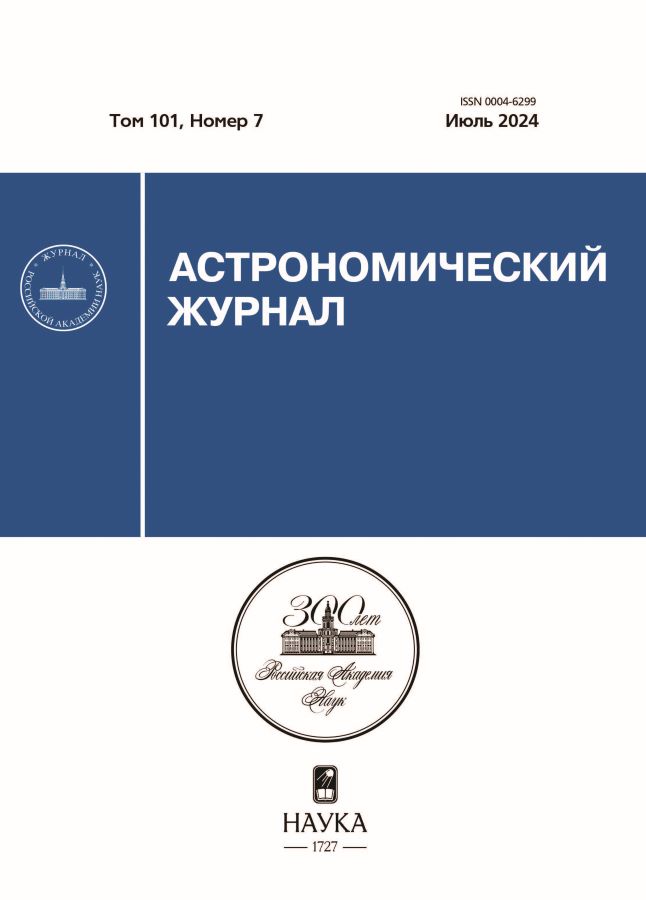Equilibrium figures of two liquid masses with synchronous rotation. Dynamics of a double asteroid (190166) 2005 UP156
- Authors: Kondratyev B.P.1,2,3
-
Affiliations:
- Moscow State University
- Sternberg Astronomical Institute, Moscow State University
- Central (Pulkovo) Astronomical Observatory, Russian Academy of Sciences
- Issue: Vol 101, No 7 (2024)
- Pages: 651-659
- Section: Articles
- URL: https://cardiosomatics.ru/0004-6299/article/view/647691
- DOI: https://doi.org/10.31857/S0004629924070074
- EDN: https://elibrary.ru/IUGWCM
- ID: 647691
Cite item
Abstract
The problem of equilibrium figures of two liquid masses in a state of tidal mutual capture is posed and solved. The condition of complete synchronous (orbital plus spin) rotation is satisfied in the system, both bodies have the same masses and congruent ellipsoidal surfaces. For each figure, in addition to its own gravity and centrifugal forces, the attraction from the second body is taken into account in the tidal approximation. The spatial form of equilibrium figures in the form of triaxial ellipsoids is found by an analytical and numerical method. It is established that the spin rotation of ellipsoidal equilibrium figures occurs not around small axes, as is usually assumed, but around the middle axes of the ellipsoids. This method is used to study the binary asteroid (190166) 2005 UP156, which approximately satisfies the initial conditions of the problem. The study showed that with the parameters known today, the system of two asteroids (190166) 2005 UP156 is nonequilibrium.
Full Text
About the authors
B. P. Kondratyev
Moscow State University; Sternberg Astronomical Institute, Moscow State University; Central (Pulkovo) Astronomical Observatory, Russian Academy of Sciences
Author for correspondence.
Email: work@boris-kondratyev.ru
Faculty of Physics
Russian Federation, Moscow; Moscow; St. PetersburgReferences
- K. V. Kholshevnikov, M. A. Borukha, B. V. Eskin, D. V. Mikryukov, Plan. and Space Sci. 181, 104777 (2020).
- G. M. Bernstein, B. J. Holler, R. Navarro-Escamilla, et al., Planetary Science Journal 4, 6, 17 (2023).
- K. S. Noll, W. M. Grundy, E. I. Chiang, J. L. Margot, S. D. Kern, in The Solar System Beyond Neptune, eds. M. A. Barucci, H. Boehnhardt, D. P. Cruikshank, and A. Morbidelli (University of Arizona Press, 2008, p. 345–363).
- J. L. Margot, M. Nolan, L. Benner, S. Ostro, et al., Science 296 (5572),1445–1448 (2002).
- P. Pravec, P. Scheirich, P. Kusnirak, et al., Icarus 181 (1) 63–93 (2006).
- A. B. Davis, D. J. Scheeres, Icarus 341, 113439 (2020).
- B. C. N. Proudfoot, D. A. Ragozzine, M. L. Thatcher, Astron. J. 167, 144, 24 (2024).
- «190166 (2005 UP156)». Minor Planet Center. Retrieved 13 September 2017.
- C. R. Nugent, A. Mainzer, J. Masiero, et al., Astrophys. J. 814, 117, 13 (2015).
- P. A. Taylor, et al., 50th Lunar and Planetary Science Conference 2019 (LPI Contrib. No. 2132) 2945. Radar and optical observations of equal-mass binary near-Earth asteroids (190166) 2005 UP156 AND 2017 YE5.
- С. Чандрасекар, Эллипсоидальные фигуры равновесия (М.: Мир, 1973).
- Б. П. Кондратьев, Динамика эллипсоидальных гравитирующих фигур (М.: Наука, 1989).
- Б. П. Кондратьев, Теория потенциала и фигуры равновесия (М.-Ижевск: РХД, 2003).
- Б. П. Кондратьев, Астрон. журн. 60, №5, 858–865 (1983).
- Б. П. Кондратьев, Астрофизика 21, №3, 499–521 (1984).
Supplementary files












